Este post também está disponível em:
Português
English
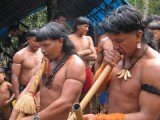
The Pataxós Indians have been concentrated in villages for at least 150 years, this indigenous group occupies the coast of Bahia on the coast of discovery, ranging from Belmonte and Santa Cruz de Cabrália, to the north, passing through Porto Seguro and Monte Pascoal, to Prado, to the south.
In the 20th century, the Pataxós suffered a great process of acculturation and were placed on the margins of society.
The results were the invasion of their territories and the almost total loss of their culture – a process intensified mainly with the implementation of large cattle ranches.
Is there anything new in a region as well known and exploited for tourism as Porto Seguro?
It is not exactly something new, as it has been there for centuries, but it can be considered a rediscovery of ecotourism for those who like to be closer to a natural and sustainable Brazil.
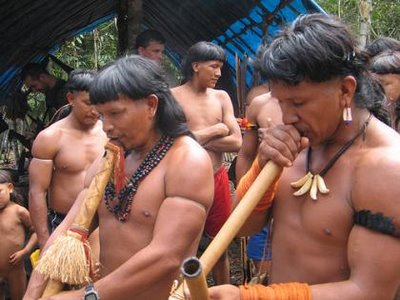

Reserva Pataxó Porto do Boi

Indios Pataxó - Documentário

Indio Pataxó - O dia do indio

Indios Kuikuro
Porto Seguro in Bahia is such a touristy little town that just hearing about it already brings to mind: carnival, axé, tour groups (which, by the way, are many there) and many, many people every season.
But there is another side to Porto Seguro that few people know about.
For now… A side where the history, culture and identity of the region are being recovered.
See the map Costa do Descobrimento and See the map of Porto Seguro beaches.
Long before the discovery of Brazil, the southern region of Bahia, including Porto Seguro, was practically entirely occupied by indigenous peoples of the Pataxó, Maxacali and Botocudo ethnic groups.
Over the centuries, they were practically extinguished by the commercial tourism we know today.
Today, there are only a few Pataxó Indians left in the region, but they are already well “acculturated” – as they say – and live very differently from the older Indians, their ancestors. Some recent documents prepared by historians even declare the end of the Pataxó ethnic group in Brazil.
But our reporting team went to see a corner where the Pataxó themselves do a daily job to rescue the identity of their people and prove otherwise.
We are talking about the Jaqueira Reserve, one of the few remnants of Atlantic Forest in southern Bahia, with an area of 825 hectares – equivalent to 82 soccer fields.
The history of this place is marked by the struggle of the Pataxós Indians for the right to the territory historically occupied by their ancestors.
On the one hand, commercial interest has always moved fast. On the other, Pataxós leaders sought the demarcation of the Indigenous Land of Coroa Vermelha, a municipality a few kilometers from Porto Seguro.
Thirteen years ago, the Jaqueira Reserve, which is part of Coroa Vermelha, was about to be deforested by a real estate group that was grabbing land along the entire coastal strip of southern Bahia.
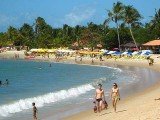
In 1997, the Pataxós Indians conquered part of the land they had always occupied. Coroa Vermelha was decreed an Indigenous Land by joint efforts led by the chief of the time.
But it was a woman, called Nitinawã Pataxó, who decided to leave the city, where they were already living, and return to live as an indigenous person.
She went to the Jaqueira Reserve together with her two sisters and her mother and, in a ritual to the earth on a full moon night, they decided to live there as they used to: in hollows, called kijemes by them, with the clothing also worn by the oldest – the women in straw skirts and coconut shells, and the men only with straw skirts – in addition to painting their skin daily, especially on the face.
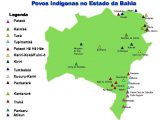
To integrate the people who were gradually leaving the urbanized village of Coroa Vermelha (after the decree, the Pataxós village still lives mainly from tourism), Nitinawã began to rescue the closed rituals, where they worship the natural elements.
Back on the land, the Indians’ main guarantee to be who they are, they realize that the 825 hectares of Atlantic Forest cannot be used as it used to be.
“We need to preserve this space. We decided not to hunt, fish or cut down the trees,” says Nitinawã. But at the same time, they needed to survive.
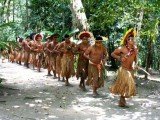
That’s when the idea of opening the Reserve to ethno-tourism, which involves cultural and environmental tourism, came up.
“This is a way for us to legitimize our culture, our customs, our identity and show the white man that we can live in harmony, as long as everyone respects each other”, concludes the indigenous leader.
Arriving at the Reserve really makes it seem like we are back in the days when the Indians were the majority in that region.
The walks through the ecological trails, guided by the Pataxós themselves, show the richness of a preserved forest and all the powers of medicinal plants – usually used by pagés to heal their tribes.
The visitor also hears lectures about the ethnic group and follows what the Pataxós call a “ritual of integration with the white man”.
At the end of the tour, which can last one or two hours, the tourist tries a fish baked in the patioba leaf, a species native to the region.
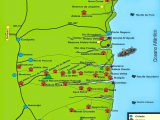
The tours cost between R$ 25.00 and R$ 35.00 per person, paid directly to the Indians, without the intermediation of travel agencies.
To supplement the income of the Pataxós who decided to remove as little as possible from the Atlantic Forest to preserve what little remains in the region, they themselves began to extract the fiber of the piassava palm, the one used to make brooms.
Before, this activity did not exist in the region because it was occupied by “white men”, but the Indians always knew how to do this type of extraction.
With the demarcation of the land, the Pataxós discovered the potential of managing the palm trees they have there. In a partnership with the BioAtlântico Institute, they mapped all the piassava trees and reached more than 20 thousand trees.
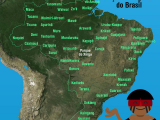
“The management plan has strengthened us and helped us learn how to extract piassava fiber so that we can work with the material all year round, which was not the case before.
We are organizing a shed inside the Jaqueira Reserve to benefit the fibre and make brooms”, explains Aderno Pataxó, a member of the village and brother-in-law of Nitinawã.
In the Jaqueira Reserve, organization, discipline, unity and respect for the conquered territory help to maintain the tradition of the Pataxó culture. If the Indians were not there, they would probably have been extinct.
To organize the tourism work, the indigenous themselves created the Pataxó Ecotourism Association in 1998. It is a new look and a great discovery of a region that was already saturated by large-scale tourism.
Pataxó Indians on the Discovery Coast of Bahia



















